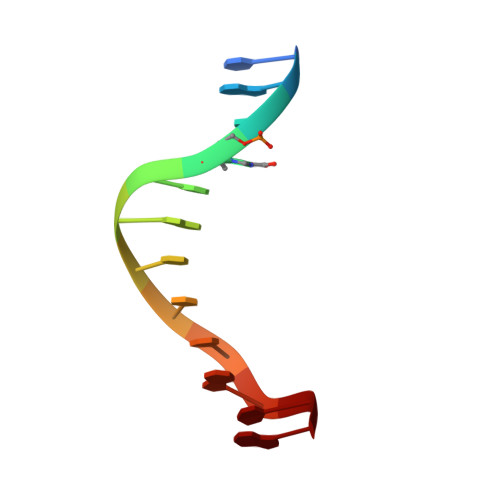Structures of DNA duplexes containing O6-carboxymethylguanine, a lesion associated with gastrointestinal cancer, reveal a mechanism for inducing pyrimidine transition mutations
Zhang, F., Tsunoda, M., Suzuki, K., Kikuchi, Y., Wilkinson, O., Millington, C.L., Margison, G.P., Williams, D.M., Czarina Morishita, E., Takenaka, A.(2013) Nucleic Acids Res 41: 5524-5532
- PubMed: 23580550
- DOI: https://doi.org/10.1093/nar/gkt198
- Primary Citation of Related Structures:
4IJ0, 4ITD - PubMed Abstract:
N-nitrosation of glycine and its derivatives generates potent alkylating agents that can lead to the formation of O(6)-carboxymethylguanine (O(6)-CMG) in DNA. O(6)-CMG has been identified in DNA derived from human colon tissue, and its occurrence has been linked to diets high in red and processed meats. By analogy to O(6)-methylguanine, O(6)-CMG is expected to be highly mutagenic, inducing G to A mutations during DNA replication that can increase the risk of gastrointestinal and other cancers. Two crystal structures of DNA dodecamers d(CGCG[O(6)-CMG]ATTCGCG) and d(CGC[O(6)-CMG]AATTCGCG) in complex with Hoechst33258 reveal that each can form a self-complementary duplex to retain the B-form conformation. Electron density maps clearly show that O(6)-CMG forms a Watson-Crick-type pair with thymine similar to the canonical A:T pair, and it forms a reversed wobble pair with cytosine. In situ structural modeling suggests that a DNA polymerase can accept the Watson-Crick-type pair of O(6)-CMG with thymine, but might also accept the reversed wobble pair of O(6)-CMG with cytosine. Thus, O(6)-CMG would permit the mis-incorporation of dTTP during DNA replication. Alternatively, the triphosphate that would be formed by carboxymethylation of the nucleotide triphosphate pool d[O(6)-CMG]TP might compete with dATP incorporation opposite thymine in a DNA template.
- Graduate School of Science and Engineering, Iwaki-Meisei University, Iwaki 970-8551, Japan.
Organizational Affiliation:


















